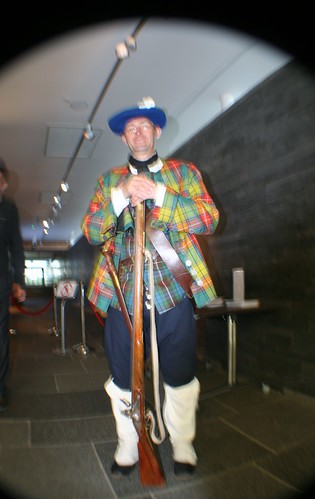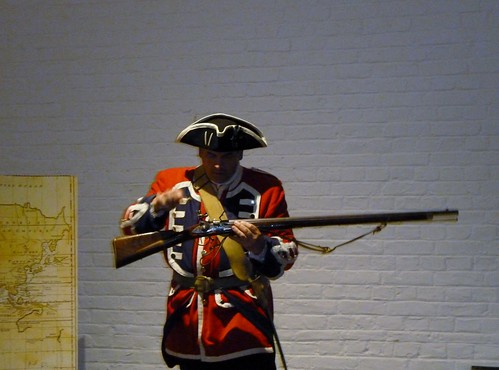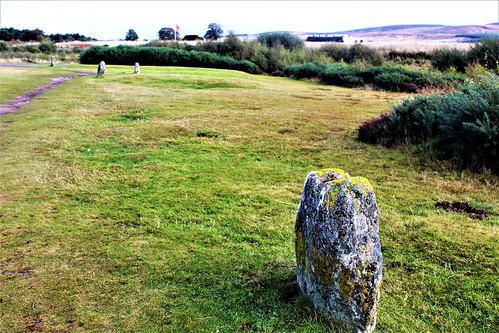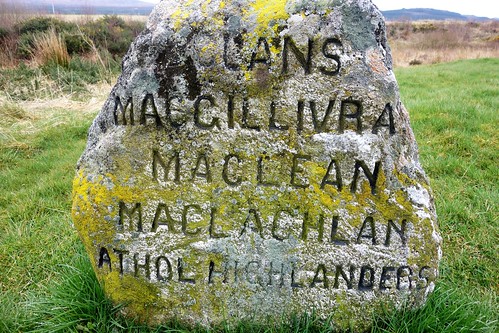Battle of Culloden, Scotland, 1746
(Above painting represents an artist's impression of the Battle of Culloden.)
This evening, I am posting a summary of the sequence of events pertaining to the last battle on British soil, in 1746. The battle site, which is about 5 miles east of Inverness in the Scottish Highlands, now forms part of an excellent visitor experience operated by the National Trust for Scotland.
On August 19th 1745 Charles Edward Stuart “Bonnie Prince Charlie” landed on the shores of Loch Shiel at Glenfinnan. This was the catalyst to a military based challenge to claim the crowns of England and Scotland for the House of Stuart. Some eighty years earlier Charles’ grandfather, James II had been evicted by the British establishment owing to James’ Catholicism subsequent to which Britain had been ruled by Protestants.
Key rehearsal: The Latin name for James is Jacob which gave rise to the term 'Jacobite' meaning a supporter of the former Stuart dynasty and the deposed King James VII (Scotland), II (England).At time of the exile of the aforesaid King James in 1688 Scotland and England were, technically, two separate countries headed by the same King but in practice were ruled directly from London, where the King resided.
Charles had the support of France which had originally supported his venture in two ways:
- Through the direct supply of ships, weapons and 700 soldiers to Charles.
- An understanding that a successful rebellion in Scotland would trigger an invasion of Southern England by France.
The West Highlands where Charles landed was a harsh terrain, remote from the rest of the country and whose people had maintained different traditions. Many were still Catholics. The tough existence grew ferocious warriors.
Call to Arms
Glenfinnan was the second point of landing.Upon arrival Charles attempted to rally support from the Highlands via a network of agents carrying crosses dipped in blood. After a prolonged wait a piper was heard which transpired to represent a 800 man contingent from Clan Cameron led by Cameron of Lochiel. Following example of the Camerons other Clan chiefs rallied to the cause. The Rising had begun.
News of the Rising caused concern, but not panic, in the capital, Edinburgh. General, Sir John Cope was charged with defence and led a his army into the impenetrable Highlands to take the fight to the Jacobites. However, the Highlands is one of the wettest and most hostile places in Britain. The Government redcoat soldiers were conspicuous in the green/grey environment whereas the Highlanders were well camouflaged. A game of cat and mouse ensued but Cope never found the rebels.
Charles’ army, having successfully evaded Cope, was now 2000 strong and resolved to target Edinburgh. In the capital over 60,000 citizens gathered to celebrate arrival of Charles. With exception of a small contingent of troops in Edinburgh Castle, the capital was secured for the Stuarts.
Edinburgh Capitulates
On hearing of Edinburgh’s capitulation, Cope raced back to the capital. His troops faced the Jacobites on open ground at Prestonpans some 10 miles east of the city.Cope’s army appeared to be well positioned- facing west between a hill and the sea and protected in front by a boggy marsh.
Battle of Prestonpans
On September 20th 1745 the Jacobites appeared with a force of some 1800 men. Cope swung his army to face them across the marsh. It should be borne in mind that the Government forces were well armed and well trained. On the other side, the Highlanders were, essentially, tribal warriors with Broadsword, Long Knife and Shield. Their secret weapon was the Highland Charge.
The marsh was the principal obstacle to the Jacobites. However, Lord George Murray (military advisor to the Charles) had learned of a hidden trail through the marsh which was unguarded by Government forces.
Using the hidden trail, Charles’ forces launched an attack which resulted in an astonishing victory for the Highlanders: the battle was over in just 15 minutes with 400 Government troops killed and 1400 captured against 40 Jacobite fatalities.
Onward to England
Bouyed by the victory at Prestonpans Charles’ army had grown to 7000. He also had supplies of gold and muskets. He took up residence at Holyrood Palace in Edinburgh. On October 3rd 1745 Charles met with his military advisors. Charles wished to invade England but Lord George Murray vehemently objected, warning of fatal risk of such an adventure. Charles won the day by just one vote.
Charles then moved on at a pace, spurred on by rumours of a French attack on England. Within 2 days he had captured Carlisle then Preston then Manchester, the latter with just a handful of troops. The Jacobites had covered 200 miles in less than 30 days without a shot being fired in anger. His troops were told that a supporting French invasion was imminent.
Derby
On December 4th 1745 Charles’ army reached Derby with forward units capturing Swarkestone Bridge 6 miles south of the town. Charles had now covered 300 miles in 4 weeks and crossed the River Trent. London was just 120 miles away.
Panic in London
The invasion from the North aggravated by rumours of an impending French invasion gave rise to hysteria in London. ‘God Save the King’ was first performed at this time as a morale building measure. There were also rumours that King George II was about the flee the country. Infantry was ordered to the northern outskirts of the city.
Disinformation
Charles had reached a standstill. There was continuing tension between Charles and Lord George Murray which had now reached breaking point. Murray was concerned because the Jacobites supply lines had become too stretched and there was no sign of the mooted French invasion. At this critical juncture news arrives from one Dudley Bradstreet, a supporter with impeccable Jacobite credentials. Bradstreet reported that a Government army of 9000 was blocking the road to London (compared against the Jacobites 5000). In fact this information was an elaborate lie; the troops never existed and Bradstreet proved to be a Government spy.
Return to Scotland
Ignorant of the deceit, Charles reluctantly agreed to return to Scotland where his troops returned somewhat despondent with a feeling of non-achievement.
Government Retribution
Charles now has to contend with a reinvigorated British army led by Britain’s top general and seasoned soldier-the Duke of Cumberland who is the second and favourite son of King George. The Duke is determined to defeat Charles.
Government Troop Tactics
Cumberland marches north but stops at Aberdeen for rest and training. Troops are taught a new bayonette drill: must not thrust into opponent immediately ahead but diagonally to the right into the Highlander’s unprotected flank between shield and arm. Success of this tactic depended on total trust between soldiers in the line. Also, troops were trained to increase rate of musket fire to 3 rounds per minute. Intensive training was the order of the day.
The Looming Battle
By spring 1746 Cumberland was ready and moved his army towards the Jacobite stronghold at Inverness. Charles elected to stand and fight at Culloden Moor, a barren, treeless, windswept, heather clad bog.
Aborted Surprise Attack
On April 15th., 1746 Charles drew up his forces. However, Murray was concerned with the terrain and favoured a surprise night attack on Cumberland’s forces who were celebrating the Duke’s 25th birthday. Charles agreed to the strategy. That night Murray led his men across country to avoid Government scouts. As the darkness closed in it became evident that the night march was too ambitious. There was too little moonlight to navigate rivers and walls, the line became dangerously stretched and many became lost. At 1 hour before dawn the Jacobite troops were ordered to return to Culloden-in an exhausted and dispirited state. A full scale battle was now inevitable.
Battle of Culloden
The opposing armies assembled at mid-morning on April 16th 1746.The armies faced each other some 400 meters apart but the two lines were not parallel. Charles had some 6000 men while Cumberland commanded some 8000. However, Charles took comfort from the famous Highland Charge to redress the imbalance.
The ground in front of the Jacobites (on the left) was boggy. They were joined by handfuls of French and Irish troops-which were held in reserve.The Jacobites front line comprised Clansmen clustered around their respective chiefs, e.g.MacDonalds.
Unfortunately, the Jacobites were not battle ready, being tired, hungry and in poor spirits. Food had not arrived from Inverness and some men had left the field to scavenge for food. However, they still retained the memory of the successful charge at Prestonpans.
The Government redcoats comprised 7 infantry regiments from England and Scotland. There were 500 men in each regiment standing 3 ranks deep. Each regiment was named after its respective Colonel, e.g. Barrel.
The Redcoats stood in well ordered ranks, each man issued with 24 rounds of ammunition and a warming tot of brandy.
Illustration of battlefield surface conditions during April, far from ideal as a platform for the famous 'Highland Charge'.
Battle Commences
At 1.00pm Charles orders his cannons to launch the battle. In response Government guns commence repetitive firing. the Jacobites stand whilst cannonballs tear into the ranks. No order is given to advance. Finally, Jacobites on the centre and right broke ranks and charged. At this stage Government gunners switch from cannon to more lethal grapeshot which produces small pieces of metal hitting directly the advancing Highlanders.The effect is devastating. The Charge degenerates into a shambles. A bunching occurred because Highlanders on the right flank had less distance to travel over dry ground whereas those in the centre drifted to the right to benefit from the firm ground and were hemmed in by a stone wall which separated the two opposing lines.Both groups charged towards the south end of the Government line which resulted in chaos. On the left flank the Highlanders moved more slowly; they had further to travel and became stuck in the boggy ground. The MacDonalds struggled to make any headway.
Barrel’s regiment took the full force of the Highland assault but stood fast. the Highlanders were packed into an unstoppable mob taking punishment from grapeshot and musket fire. The Highlanders crashed into Barrel’s regiment and now had the advantage; they could use their broadswords and dirks to awesome effect. Barrel’s soldiers were hacked down and the line smashed open. Then the Highlanders attacked Munro’s regiment alongside that of Barrel.
Actor illustrating Jacobite cavalryman
Redcoat Soldier.(Uniform was red in colour because it was the cheapest cloth available at the time.)
Turning Point
The momentum of the charge had been dissipated. However, despite the Highlanders initial success the Redcoats did not turn and run. Cumberland moved up forces from the second line to reinforce the struggling front line. This was the pivotal point of the battle.The Jacobite command had no control over its troops. Highlanders pitched into the gap in the redcoat ranks and straight into the musket fire from the soldiers of the second line. The Highlanders became surrounded by Redcoats who were in a horseshoe shape and the resulting slaughter is estimated to have killed/wounded about 700 in just 2 or 3 minutes.
The Highlanders retreated the way the had come-straight into a hail of musket fire from Government forces which had moved up behind the wall on the left.
Battle Lost
At this stage Charles is persuaded to leave the field and Cumberland commences his retribution for which he was awarded the nickname “butcher”. No mercy was shown. Any injured clansmen on the field were shot, clubbed or bayonetted to death. About 200 Clansmen were buried where they fell. So ended the last battle on British soil.
That summer Government forces carried a vicious policy of “pacification” entailing the immediate slaughter of any one suspected of Jacobite tendencies. Also, the Gaelic language, bagpipes and tartan was banned. The Highland way of life was destroyed with thousands deported to the New World. Government policy of repression continued for decades.
Charles had a GBP30,000 price on his head. He eventually escaped to the Continent (of Europe) and died a drunken wreck 42 years later.
Culloden Battlefield today with stone memorials indicating the mass burials of the individual clans.
Stone marker indicating a burial place of four clans.
Inscription on principal memorial cairn on the battlefield.
Implications of Culloden
The battle marked commencement of a long period of stability. Now secure at home the British government turned its attention to building an empire abroad.








Comments
Post a Comment